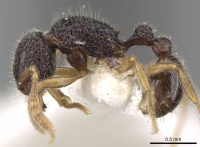Tetramorium vandalum
| Tetramorium vandalum | |
|---|---|

| |
| Scientific classification | |
| Kingdom: | Animalia |
| Phylum: | Arthropoda |
| Class: | Insecta |
| Order: | Hymenoptera |
| Family: | Formicidae |
| Subfamily: | Myrmicinae |
| Tribe: | Crematogastrini |
| Genus: | Tetramorium |
| Species: | T. vandalum |
| Binomial name | |
| Tetramorium vandalum Bolton, 1977 | |
The type material was collected from a forest litter-sample.
Identification
A member of the Tetramorium tonganum-species group.
Bolton (1977) - Related to Tetramorium tonganum and its allies, vandalum is separated from them by its dark colour and the presence of standing hairs on the dorsal surfaces of the hind tibiae.
Distribution
Latitudinal Distribution Pattern
Latitudinal Range: -4.216666667° to -7.345833°.
| North Temperate |
North Subtropical |
Tropical | South Subtropical |
South Temperate |
- Source: AntMaps
Distribution based on Regional Taxon Lists
Indo-Australian Region: New Guinea (type locality).
Distribution based on AntMaps
Distribution based on AntWeb specimens
Check data from AntWeb
Countries Occupied
| Number of countries occupied by this species based on AntWiki Regional Taxon Lists. In general, fewer countries occupied indicates a narrower range, while more countries indicates a more widespread species. |

|
Estimated Abundance
| Relative abundance based on number of AntMaps records per species (this species within the purple bar). Fewer records (to the left) indicates a less abundant/encountered species while more records (to the right) indicates more abundant/encountered species. |

|
Biology
Castes
Nomenclature
The following information is derived from Barry Bolton's Online Catalogue of the Ants of the World.
- vandalum. Tetramorium vandalum Bolton, 1977: 130, fig. 57 (w.q.) NEW GUINEA.
Unless otherwise noted the text for the remainder of this section is reported from the publication that includes the original description.
Description
Worker
Holotype. TL 3.1, HL 0.72, HW 0.64, CI 89, SL 0.58, SI 90, PW 0.50, AL 0.90.
Mandibles striate; anterior clypeal margin entire and convex, the anterior apron or flange narrow and inconspicuous. Frontal carinae extending back beyond the level of the eyes but no more strongly developed than the rugular sculpture of the cephalic dorsum, the carinae fading and becoming inseparable from the remaining cephalic sculpture before reaching the occiput. Impressions of antennal scrobes shallow, only feebly developed. Eyes of moderate size, maximum diameter C. 0.14, about 0.22 x HW. Occipital margin shallowly concave in full-face view. Pronotal corners in dorsal view very broadly rounded. Propodeal spines short, about as long as the meta pleural lobes, the spines themselves narrow and acute, slightly elevated; metapleural lobes broadly triangular. Petiole in profile with a narrow, downcurved anterior peduncle, the node shaped as in figure. Petiole node in dorsal view slightly broader than long. Dorsum of head strongly rugulose, the rugulae irregular and meandering, with numerous cross-meshes; occipital region with a disorganized ruguloreticulum. Dorsum of alitrunk reticulate-rugulose. Sides of petiole and postpetiole sculptured and the dorsal surfaces of these segments with traces of sculpture which are better developed on the petiole than the postpetiole. Gaster unsculptured. All dorsal surfaces of head and body with numerous fine hairs of varying length but antennal scapes only with quite dense, short pubescence of about uniform length. Dorsal (outer) surfaces of hind tibiae equipped with a dense coat of short hairs which are erect, suberect or subdecumbent. Colour uniform blackish brown, the appendages pale yellow-brown.
Paratypes. As holotype but showing variation in thickness and length of propodeal spines. In some the spines are slightly longer than the metapleural lobes, in others distinctly shorter. In one specimen the spines are almost as broad basally as they are long, whereas in the others the spines are obviously longer than their basal width. Postpetiole is almost unsculptured in some individuals. Range of dimensions of paratype workers: TL 2.9-3.2, HL 0.68-0.72, HW 0.58-0.64, CI 84-89, SL 0.52-0.58, SI 87-93, PW 0.46-0.52, AL 0.84-0.90 (10 measured). Maximum diameter of eye C. 0.13-0.14, about 0.22-0.24 x HW.
Type Material
Holotype worker, New Guinea: Papua, Wau, 4000 ft, l.vii.1974, for. litter (S. Peck) (Museum of Comparative Zoology). Paratypes. 15 workers and 5 dealate females with same data as holotype (MCZC; The Natural History Museum; Naturhistorisches Museum, Basel).
References
- Bolton, B. 1977. The ant tribe Tetramoriini (Hymenoptera: Formicidae). The genus Tetramorium Mayr in the Oriental and Indo-Australian regions, and in Australia. Bulletin of the British Museum (Natural History). Entomology. 36:67-151. (page 130, fig. 57 worker, queen described)
References based on Global Ant Biodiversity Informatics
- Bolton B. 1977. The ant tribe Tetramoriini (Hymenoptera: Formicidae). The genus Tetramorium Mayr in the Oriental and Indo-Australian regions, and in Australia. Bulletin of the British Museum (Natural History). Entomology 36:67-151.
- Bolton, B. "The ant tribe Tetramoriini (Hymenoptera: Formicinae. The genus Tetramorium Mayr in the Oriental and Indo-Australian regions and in Australia." Bulletin of the British Museum (National History): Entomology series 36, no. 2 (1977): 68-151.
- Janda M., G. D. Alpert, M. L. Borowiec, E. P. Economo, P. Klimes, E. Sarnat, and S. O. Shattuck. 2011. Cheklist of ants described and recorded from New Guinea and associated islands. Available on http://www.newguineants.org/. Accessed on 24th Feb. 2011.
- Lucky A., E. Sarnat, and L. Alonso. 2011. Ants of the Muller Range, Papua New Guinea, Chapter 10. In Richards, S. J. and Gamui, B. G. (editors). 2013. Rapid Biological Assessments of the Nakanai Mountains and the upper Strickland Basin: surveying the biodiversity of Papua New Guineas sublime karst environments. RAP Bulletin of Biological Assessment 60. Conservation International. Arlington, VA.
- Roncin E. 2002. Two new Tetramorium species (Hymenoptera: Formicidae) from Vietnam with a discussion of the mixtum, tonganum, and scabrosum groups. Sociobiology 40: 281-292.
- Sagata, K., A.L. Mack, D.D. Wright and P.J. Lester. 2010. The influence of nest avaiability on the abundance and diversity of twig-dwelling ants in a Papua New Guinea forest. Insectes Sociaux 57:333-341

